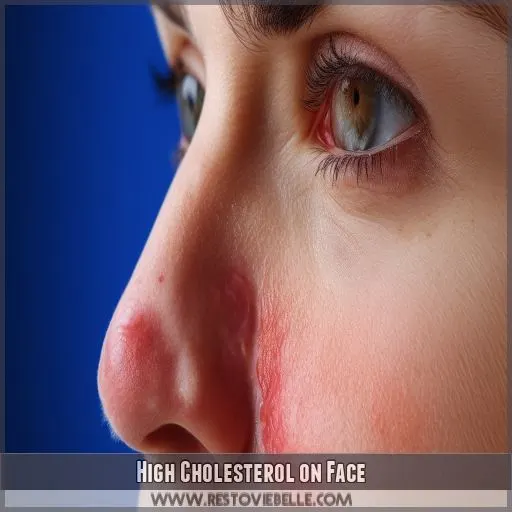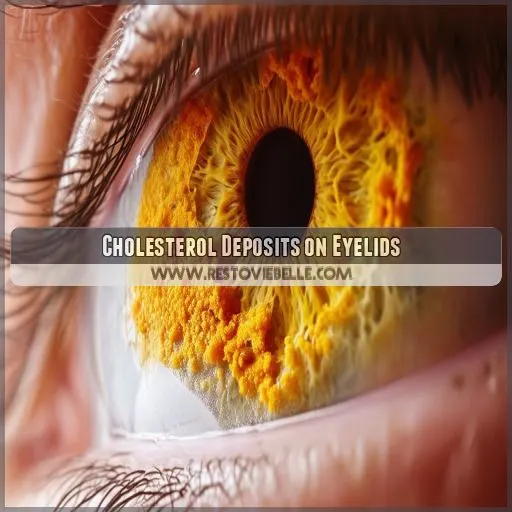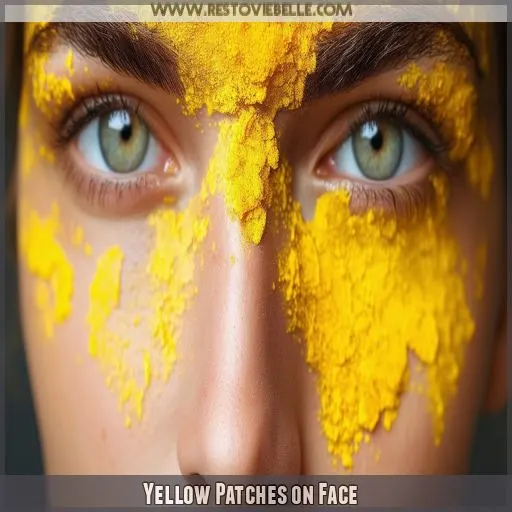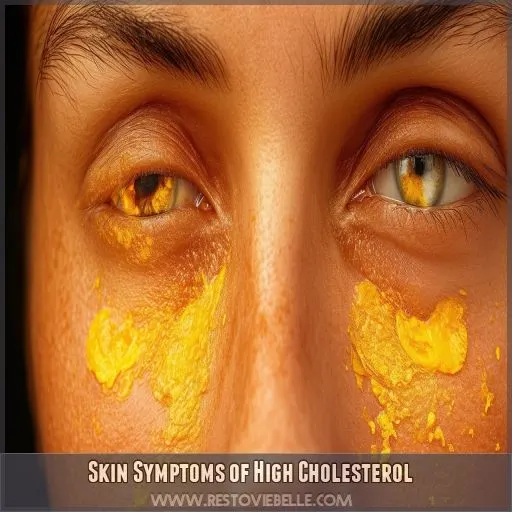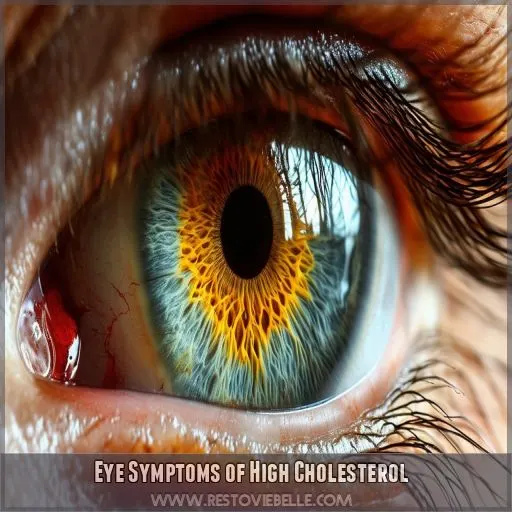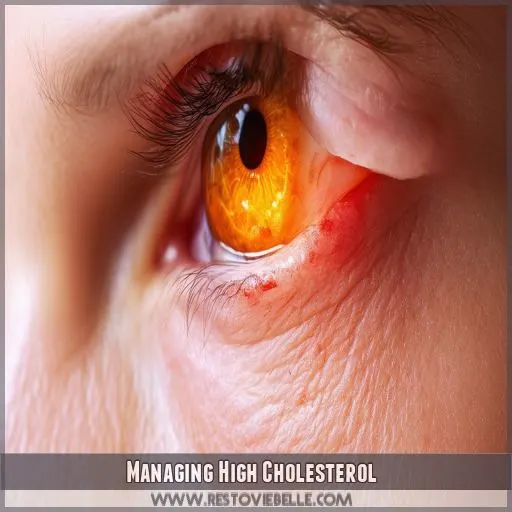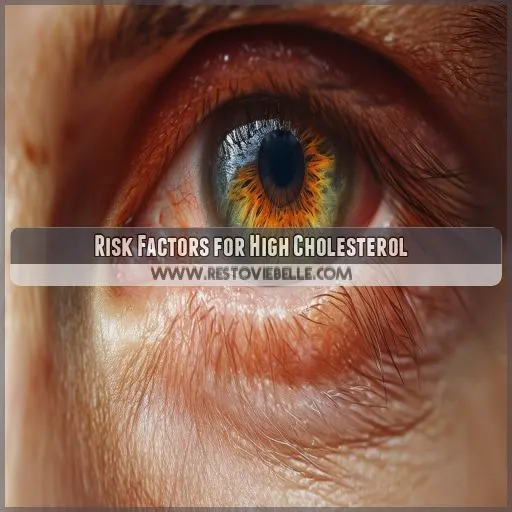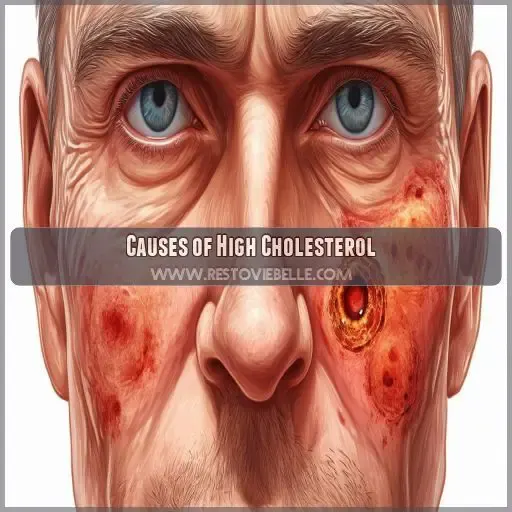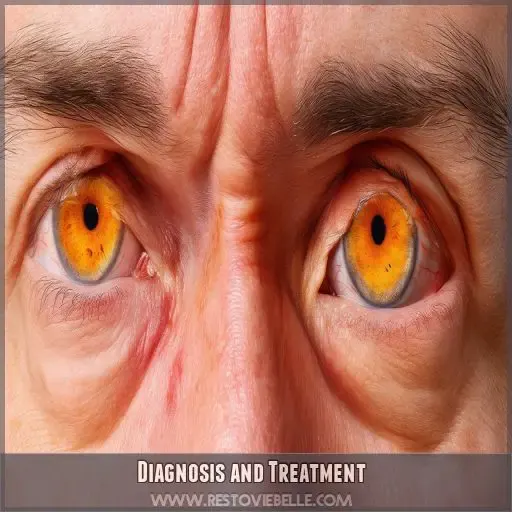This site is supported by our readers. We may earn a commission, at no cost to you, if you purchase through links.
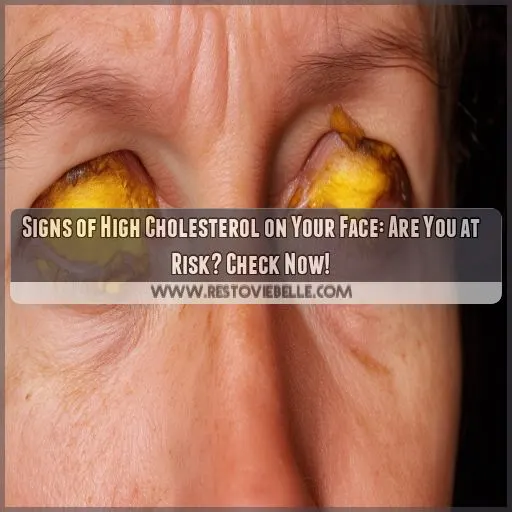
Table Of Contents
- Key Takeaways
- What Are the Signs of High Cholesterol on Your Face?
- High Cholesterol on Face
- Cholesterol Deposits on Eyelids
- Yellow Patches on Face
- Skin Symptoms of High Cholesterol
- Eye Symptoms of High Cholesterol
- Managing High Cholesterol
- Risk Factors for High Cholesterol
- Causes of High Cholesterol
- Diagnosis and Treatment
- Frequently Asked Questions (FAQs)
- What are two signs of high cholesterol in the face?
- How do I get rid of cholesterol deposits on my face?
- How does your body feel when your cholesterol is too high?
- What do cholesterol bumps look like?
- Can high cholesterol cause facial redness or flushing?
- Are there any signs of high cholesterol in ear shape?
- Do facial wrinkles indicate high cholesterol levels?
- Can high cholesterol affect facial hair growth patterns?
- Is facial asymmetry a potential sign of high cholesterol?
- Conclusion
Key Takeaways
- Your peepers might be playing detective! Keep an eye out for xanthelasmas (those pesky yellowish bumps around your eyes) and corneal arcus (a grayish ring circling your iris) – they’re like nature’s "Check Engine" light for your cholesterol levels.
- Don’t let your face become a billboard for high cholesterol! Eruptive xanthomas (small, colorful bumps) and yellow patches could be your skin’s way of staging an intervention. It’s time to listen up and give your doc a ring!
- Psst… your skin might be trying to tell you something. Lichen planus (an itchy rash) and psoriasis flare-ups could be secret informants, whispering about your cholesterol levels. Don’t brush off these scaly messengers!
- Remember, your face isn’t just for selfies – it’s a health monitor too! While wrinkles and facial asymmetry aren’t cholesterol tattletales, those sneaky xanthomas could pop up anywhere, even on your ears. Keep your eyes peeled and your cholesterol in check!
What Are the Signs of High Cholesterol on Your Face?
Ever wondered if your face is trying to tell you something about your cholesterol? Well, it might be! Signs of high cholesterol on your face can include yellowish bumps around your eyes called xanthelasma. These little troublemakers are like tiny billboards saying, "Hey, check your cholesterol!" You might also notice a grayish-white ring around your iris, known as corneal arcus. And if you’re suddenly sporting scaly patches or an itchy rash, your skin could be waving a red flag about your cholesterol levels. Don’t panic, though! These signs aren’t a definitive diagnosis, but they’re definitely worth investigating. Ready to become a face-reading cholesterol detective?
High Cholesterol on Face
Your face might be trying to tell you something important about your health. Did you know that high cholesterol can show up in surprising ways on your face, from yellowish bumps around your eyes to a grayish ring around your iris?
Xanthelasma: Yellowish Bumps Around Eyes
Ever noticed small, yellowish bumps around your eyes? They might be xanthelasmas, a sign of high cholesterol. These pesky deposits can:
- Appear suddenly
- Grow over time
- Be painless
- Signal underlying health issues
Corneal Arcus: Grayish-White Ring Around Iris
Ever noticed a grayish-white ring around your iris? That’s corneal arcus, and it might be waving a red flag about your cholesterol levels. Let’s break it down:
| Corneal Arcus 101 | What It Means for You |
|---|---|
| What’s it? | Grayish-white ring around iris |
| Cause | High cholesterol deposits |
| Age factor | Common in older adults |
| Risk indicator | May signal cardiovascular risk |
| Action needed | Time for a cholesterol check! |
Lichen Planus: Itchy Rash Linked to High Cholesterol
While you’re checking your eyes, don’t forget about your skin! Lichen planus, an itchy rash, might be linked to high cholesterol. Here’s what to look out for:
- Purple, flat-topped bumps
- Lacy white patches
- Itchy, inflamed areas
Psoriasis: Scaly Patches Triggered by High Cholesterol
Psoriasis isn’t just skin-deep. Those scaly patches might be waving a red flag about your cholesterol levels. Let’s take a closer look at the connection:
| Psoriasis Symptom | Cholesterol Link | Treatment |
|---|---|---|
| Red, scaly patches | May indicate high LDL | Topical creams |
Itchy, inflamed skin
Persistent flare-ups
Cholesterol Deposits on Eyelids
Ever noticed small, yellowish bumps around your eyes? They might be more than just a cosmetic concern. These cholesterol deposits, known as xanthelasma palpebrarum, could be a sign that your cholesterol levels are higher than they should be.
Xanthelasma Palpebrarum: Small Bumps Under Skin
- Appearance: Soft, flat patches
- Location: Usually on upper eyelids
- Size: Can grow larger over time
Causes of Cholesterol Deposits on Eyelids
Ever wonder why you’ve got those pesky yellow bumps around your eyes? It’s not just beauty sleep you’re missing! High cholesterol, genetics, and certain medical conditions can cause these eyelid deposits. Don’t panic – understanding the causes is your first step to clearer skin.
Treatment Options for Cholesterol Deposits on Eyelids
You’ve got options for those pesky eyelid deposits! From cholesterol-lowering meds to surgical removal, there’s a treatment that’ll fit you like a glove. Don’t sweat it – your doc can help you choose the best path forward. Let’s tackle this together!
Yellow Patches on Face
You might be surprised to learn that your face can reveal signs of high cholesterol. Yellow patches, known as eruptive xanthomas, could be a warning sign that it’s time to check your cholesterol levels and take action for your health.
Eruptive Xanthomas: Pink, Reddish, or Yellow Nodules
Ever noticed small, colorful bumps popping up on your skin? They might be eruptive xanthomas, a telltale sign of high cholesterol. These pink, reddish, or yellow nodules can appear suddenly, often on your elbows, knees, or buttocks. Time for a cholesterol check!
Causes of Yellow Patches on Face
Your yellow face patches mightn’t just be a suntan gone wrong. These pesky pigments could be telling you something important about your health. Here are some potential causes:
- High cholesterol levels
- Liver dysfunction
- Hormonal imbalances
- Vitamin deficiencies
- Certain medications
Treatment Options for Yellow Patches on Face
Worried about those yellow patches on your face? Don’t fret! Your doctor can recommend effective treatment options, from lifestyle changes to medical procedures. Remember, tackling high cholesterol is key. Take charge of your health and say goodbye to those pesky patches!
Skin Symptoms of High Cholesterol
Your skin can be a window into your health, and high cholesterol might be leaving its mark right on your face. From yellowish bumps around your eyes to scaly patches on your skin, these visible signs could be your body’s way of waving a red flag about your cholesterol levels.
Xanthoma: Localized Fat Deposits Affecting Skin
Moving on from yellow patches, let’s talk about xanthomas – the skin’s not-so-subtle way of waving a red flag for high cholesterol. These localized fat deposits can pop up anywhere, like uninvited guests at a party. But don’t panic! Understanding xanthomas is your first step to taking control.
Here’s what you need to know:
- Xanthomas come in various shapes and sizes
- They’re often painless but can be cosmetically concerning
- Not all xanthomas mean high cholesterol, but it’s worth checking
- Treatment options range from lifestyle changes to medical procedures
Eruptive Xanthoma: Rash-Like Appearance
Ever noticed tiny, rash-like bumps popping up on your skin? They might be eruptive xanthomas, a telltale sign of sky-high cholesterol. These pesky little bumps can appear suddenly, looking like uninvited guests at a skin party. Don’t panic, though! While they’re a red flag for your health, they’re also your body’s way of saying, "Hey, let’s get that cholesterol in check!
Eye Symptoms of High Cholesterol
Your eyes might be telling you more than you think about your cholesterol levels. From yellowish bumps around your peepers to a grayish ring circling your iris, these subtle signs could be your body’s way of waving a red flag about high cholesterol.
Xanthelasmas
Ever noticed small, yellowish bumps around your eyes? They might be xanthelasmas, cholesterol deposits signaling high levels. Don’t panic! While they’re a health warning sign, they’re treatable. Regular checkups and lifestyle changes can help manage your cholesterol and keep your peepers bump-free.
Corneal Arcus
Another eye-catching sign of high cholesterol is corneal arcus. This grayish-white ring around your iris might seem harmless, but it’s a telltale sign you shouldn’t ignore. Here’s what you need to know:
- Appears gradually, often starting at the top and bottom of the cornea
- More common in older adults, but can occur at any age
- Doesn’t typically affect vision, but signals underlying health issues
- Early detection can lead to timely cholesterol management
Lichen Planus
While lichen planus isn’t directly caused by high cholesterol, there’s a link between the two. This itchy rash might be a red flag for your heart health. If you notice flat, purplish bumps on your skin, it’s time for a checkup!
Managing High Cholesterol
Managing high cholesterol isn’t just about popping pills – it’s a lifestyle makeover. You’ve got the power to take control of your health by making smart choices in your diet, exercise routine, and overall habits.
Healthy Diet: Focus on Low-Fat Foods and Fruits
- Load up on colorful fruits
- Choose lean proteins
- Embrace heart-healthy fats
Your taste buds won’t even notice the difference!
Exercise: Regular Physical Activity Raises HDL
Regular exercise is your heart’s best friend! It boosts HDL (good cholesterol) and keeps your ticker happy. Let’s break down some heart-pumping activities:
| Activity | Intensity | Duration | Benefits |
|---|---|---|---|
| Brisk walking | Moderate | 30 min/day | Easy on joints |
| Swimming | Low-impact | 45 min/3x week | Full-body workout |
| Cycling | Variable | 20-30 min/day | Outdoor fun |
| HIIT workouts | High | 15-20 min/3x week | Time-efficient |
Maintain a Healthy Weight: Losing Excess Weight Improves Cholesterol
Maintaining a healthy weight isn’t just about looking good—it’s a cholesterol game-changer! Shedding those extra pounds can boost your HDL and lower LDL. Ready to tip the scales in your favor?
Medications: Statins to Lower Cholesterol Levels
If lifestyle changes aren’t enough, your doctor might prescribe statins. These cholesterol-busting superheroes work wonders, but remember, they’re not a free pass to skip the salad! Regular checkups are key.
Risk Factors for High Cholesterol
You might be surprised to learn that your face can reveal signs of high cholesterol. From yellowish bumps around your eyes to a grayish-white ring around your iris, these subtle facial clues could be your body’s way of waving a red flag about your cholesterol levels.
Unhealthy Diet High in Saturated and Trans Fats
Your diet might be a sneaky cholesterol culprit! Watch out for those saturated and trans fats lurking in your food choices. They’re like little troublemakers for your heart health.
- Butter, cheese, and fatty meats are saturated fat hotspots
- Trans fats hide in fried foods and baked goods
- Swap these for heart-friendly options like olive oil and nuts
Lack of Exercise Negatively Impacts HDL
Couch potatoes, beware! Your sedentary lifestyle’s sabotaging your HDL, the "good" cholesterol. Research shows exercise is a game-changer for boosting HDL levels. Ready to trade remote for running shoes? Your heart will thank you!
Obesity Increases Risk of High Cholesterol
Carrying extra weight? Your cholesterol might be sky-high! Obesity and high cholesterol often go hand in hand. Here’s why your waistline matters:
- Fat cells produce more cholesterol
- Excess weight lowers "good" HDL cholesterol
- Obesity increases inflammation, affecting cholesterol metabolism
- Weight gain can lead to insulin resistance, impacting lipid levels
Smoking Lowers HDL
Smoking’s not just bad for your lungs; it’s also a cholesterol killer. It lowers your HDL (the good guy), leaving you vulnerable to heart disease. Time to kick that habit, pronto!
Causes of High Cholesterol
You might be surprised to learn that high cholesterol isn’t just about what’s on your plate. From genetics to certain medical conditions, there are several sneaky culprits that can send your cholesterol levels soaring.
Genetics: Inherited Traits Affecting Cholesterol Levels
Your genes might be playing a sneaky game with your cholesterol levels. Family history can stack the deck, but don’t worry – knowledge is power. Genetic testing can help you beat the odds.
Medical Conditions: Diabetes, Chronic Kidney Disease, Hypothyroidism, and Lupus
While genetics play a role, certain medical conditions can also wreak havoc on your cholesterol levels. Let’s take a closer look at how diabetes, chronic kidney disease, hypothyroidism, and lupus might be secret cholesterol culprits.
Poor Dietary Habits: High-Saturated and Trans Fat Intake
Your diet’s a major player in the cholesterol game. Want to keep those face signs at bay? Watch out for these dietary culprits:
- Sneaky trans fats in processed foods
- Saturated fat overload from fatty meats
- Hidden sugars in seemingly healthy snacks
Sedentary Lifestyle: Lack of Physical Activity
You’re not alone in the couch potato club! A sedentary lifestyle can sneak up on you, raising your cholesterol and health risks. Let’s break down the impact:
| Activity Level | Cholesterol Effect | Heart Risk |
|---|---|---|
| Couch Potato | LDL ↑, HDL ↓ | High |
| Weekend Warrior | Slight Improvement | Moderate |
| Regular Mover | LDL ↓, HDL ↑ | Lower |
| Fitness Fanatic | Best Levels | Lowest |
Diagnosis and Treatment
If you’re worried about high cholesterol, your face might be giving you some clues. Let’s explore how doctors diagnose and treat this common condition, and what those telltale signs on your skin could mean for your health.
Lipid Panel: Measuring Total Cholesterol in Blood
Now, let’s talk about your lipid panel. It’s like a report card for your cholesterol levels. This blood test gives your doctor the lowdown on what’s happening in your arteries.
Blood Tests: Monitoring Cholesterol Levels
After your lipid panel, you’ll need regular blood tests to monitor your cholesterol levels. It’s like keeping tabs on your car’s oil – essential for smooth running! Don’t skip those checkups!
Lifestyle Changes: Diet, Exercise, and Stress Management
Now that you’ve got your results, it’s time to take action. Lifestyle changes can work wonders for your cholesterol levels. Here’s what you can do:
- Swap greasy burgers for colorful salads
- Turn your living room into a mini gym
- Transform stress into peaceful zen moments
Medications: Statins and Other Cholesterol-Lowering Drugs
If lifestyle changes aren’t enough, your doctor might prescribe statins or other cholesterol-lowering drugs. These medications can be real lifesavers, but remember to discuss potential side effects and interactions with your healthcare provider.
Frequently Asked Questions (FAQs)
What are two signs of high cholesterol in the face?
You might notice two telltale signs of high cholesterol on your face: xanthelasmas and corneal arcus. These sneaky culprits appear as yellowish bumps around your eyes and a grayish ring circling your cornea. Don’t ignore these facial clues!
How do I get rid of cholesterol deposits on my face?
To tackle those pesky cholesterol deposits, you’ll need a two-pronged approach. First, consult your doctor about cholesterol-lowering medications. Then, focus on lifestyle changes: eat heart-healthy foods, exercise regularly, and kick those bad habits to the curb. It’s face-saving time!
How does your body feel when your cholesterol is too high?
You might think high cholesterol’s silent, but your body’s whispering. You’ll feel fatigue, experience chest pain, and notice numbness in extremities. Don’t ignore these signs – they’re your body’s way of waving a red flag. Listen up!
What do cholesterol bumps look like?
Cholesterol bumps, or xanthomas, often look like small, yellowish-orange lumps under your skin. You’ll typically spot these pesky little guys around your eyes, knuckles, or elbows. They’re like unwanted guests at a party – noticeable but usually harmless.
Can high cholesterol cause facial redness or flushing?
You’ll be redder than a tomato! While high cholesterol doesn’t directly cause facial redness, it can lead to inflammation and narrowed blood vessels. This might make you more prone to flushing, especially after eating or drinking alcohol.
Are there any signs of high cholesterol in ear shape?
While ear shape isn’t directly linked to high cholesterol, you might notice small, yellowish bumps called xanthomas on or around your ears. These fatty deposits can signal elevated cholesterol levels. Don’t worry, though – they’re not common!
Do facial wrinkles indicate high cholesterol levels?
You might think wrinkles are a telltale sign of high cholesterol, but that’s not the case. While they can indicate aging or sun damage, facial wrinkles aren’t directly linked to cholesterol levels. Don’t worry – your wrinkles aren’t tattling on you!
Can high cholesterol affect facial hair growth patterns?
While high cholesterol doesn’t directly affect facial hair growth, it can impact overall health. You might notice changes in hair texture or growth rate, but these aren’t specific indicators. Keep an eye on your cholesterol levels for better health.
Is facial asymmetry a potential sign of high cholesterol?
Hold your horses, partner! Facial asymmetry isn’t typically a sign of high cholesterol. While your face can show some signs like xanthelasmas (yellowish bumps around eyes), asymmetry’s usually due to other factors. Don’t let cholesterol worries throw you off balance!
Conclusion
Did you know that over 95 million Americans have high cholesterol? That’s why noticing signs of high cholesterol on your face is important. From yellowish bumps to grayish rings, your face might be trying to tell you something. Don’t ignore these warning signs! By recognizing these facial clues, you’re taking the first step toward better health. Remember, high cholesterol doesn’t have to be a silent threat. Regular check-ups, a healthy diet, and exercise can keep your cholesterol in check. Your face – and your heart – will thank you!

